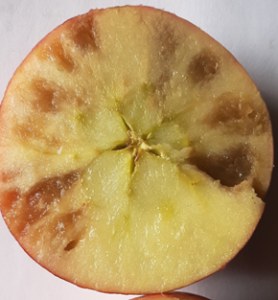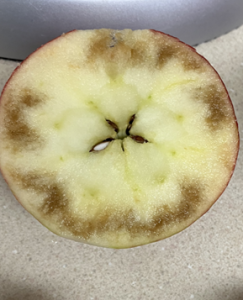Tree Fruit Newsletter — October 3, 2023
Maturity Report and Guest Article by Kendra McClure
Maturity Report
McIntosh: Both strains are past the stage to pick for storage based on starch index and signs of fruit drop during limb shaking. Trees at Highmoor Farm had about 20% fruit drop with a good shake of the limbs.
Cortland: Cortland is at a stage where it is ready to pick for storage. They are susceptible to superficial scald and should be treated with an antiscald material such as 1-MCP (SmartFresh) and DPA (No-Scald). 1-MCP is not fully effective by itself.
Honeycrisp: This variety should be completely harvested soon. Apples from the block with some internal frost damage are over ripe for storage. Apples from a block with almost no frost damage have been picked twice, but the under ripe fruit remained and were used in today’s test. A Delta Absorbance reading of 0.3 in Honeycrisp is the cutoff for storage. This variety is highly susceptible to chilling injury at this time and should be conditioned prior to cold storage. To condition, hold apples at 50 to 70°F for five to seven days before putting into cold storage at 36 to 38°F.
Golden Delicious: Flavor has developed and peel color is changing to yellow on some fruits. Based on starch index, this variety is ready to harvest for storage. For immediate sales, quality will improve with a few more days on the tree.
Northern Spy: Starch breakdown is just beginning.
Empire: This variety was not tested.
| Variety | Starch Index | Delta Absorbance meter reading* |
|---|---|---|
| McIntosh standard Strain | 6.6 | 1.73 |
| McIntosh spur type | 7.2 | 1.61 |
| Honeycrisp harvested twice | 6.0 | 0.84 |
| Honeycrisp with frost damage | 7.3 | 0.26 |
| Cortland | 2.5 | 1.26 |
| Golden Delicious | 4.0 | — |
| Northern Spy | 1.8 | — |
*Delta reading is a measure of chlorophyll breakdown in the peel and change in ground color from green to yellow. Starch index is a measure of starch breakdown, so the index number increases as fruit ripen.

Guest Article by Kendra McClure, New Brunswick Department of Agriculture
During last month’s grower call we discussed internal browning that was observed at a grower’s farm near Woodstock. Nearly all Honeycrisp were affected, and fruit were displaying symptoms while still maturing on the tree (August-September). At that time several growers checked their trees, and it appeared that the browning was limited to this one location. This weekend I was contacted by Dr. Moran from the University of Maine saying that they are also observing this type of browning in their Honeycrisp. I have attached her photo, and one of mine from the NB site affected. In the case of the NB grower, symptoms were not visible from the outside of the fruit in August-September; it was not until fruit were cut in half that any type of symptoms were observed. Dr. Moran said that she did see external symptoms and thinks it could perhaps be linked to a freeze that affected NY and most of New England during the latter part of bloom (May 18). Like us, they are also seeing pumpkin shaped fruit in Maine.
We did not think this was widespread in August-September, but since there were no external symptoms at that time, you would not know unless you checked. I would recommend that when harvesting Honeycrisp, take some time to cut fruit open to check for browning. If it is temperature related, make sure to check low points in your orchard, or areas that have been prone to frost damage in the past.
Have a good week,

Kendra McClure, Crop Development Specialist – Tree fruit/Nursery/Floriculture
New Brunswick Department of Agriculture, Aquaculture and Fisheries
Office phone: (506) 453-3470
Cell phone: (506) 230-1537
E-mail: Kendra.McClure@gnb.ca
Renae Moran
UMaine Cooperative Extension Tree Fruits Program
University of Maine Cooperative Extension
PO Box 179
Monmouth, ME 04259
(207) 933-2100
rmoran@maine.edu
In complying with the letter and spirit of applicable laws and pursuing its own goals of diversity, the University of Maine System does not discriminate on the grounds of race, color, religion, sex, sexual orientation, transgender status, gender, gender identity or expression, ethnicity, national origin, citizenship status, familial status, ancestry, age, disability physical or mental, genetic information, or veterans or military status in employment, education, and all other programs and activities. The University provides reasonable accommodations to qualified individuals with disabilities upon request. The following person has been designated to handle inquiries regarding non-discrimination policies: Director of Equal Opportunity, 5713 Chadbourne Hall, Room 412, University of Maine, Orono, ME 04469-5713, 207.581.1226, TTY 711 (Maine Relay System).
